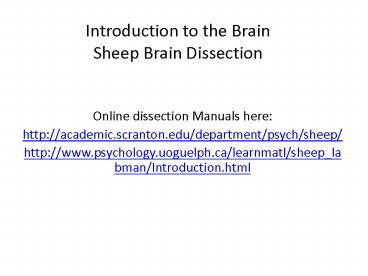Introduction to the Brain Sheep Brain Dissection PowerPoint PPT Presentation
1 / 30
Title: Introduction to the Brain Sheep Brain Dissection
1
Introduction to the BrainSheep Brain Dissection
- Online dissection Manuals here
- http//academic.scranton.edu/department/psych/shee
p/ - http//www.psychology.uoguelph.ca/learnmatl/sheep_
labman/Introduction.html
2
Anatomy First Then Function
Human brain
Sheep Brain
Parts of the brain (please watch!) Animation
I Animation II
3
Development of the Brain
steps that lead to embryo formation (general)
http//www.youtube.com/watch?vUgT5rUQ9EmQ
(more specific) http//www.hhmi.org/biointeractive
/media/dev_human_emb_brain-lg.mov
4
Development of the brain and ventricles
5
Inadequate amounts of folic acid can contribute
to neural tube defects
- 1/1000 births have anencephaly or other neural
tube defect (spina bifida) - Neural tube develops early 22 days after
fertilization (many women do not know they are
pregnant) - Diet rich in folic acid (B vitamin found in green
leafy vegetables, legumes, citrus fruits) lessens
the risk of developing neural tube defects (70).
Food is fortified with folic acid (added to
cereal). - US government fortifies grains (cereal)
Folic Acid http//cerhr.niehs.nih.gov/common/fol
ic-acid.html
Real challenging photos http//www.pathology.vcu.
edu/WirSelfInst/devdis.html
6
Development of CNS - Details
7
Protective Covering Skull and Meninges
- Dura mater consists of an outer periosteal layer
and an inner (meningeal layer) - In a few places, between the layers there are
dural sinuses - Dural septa (flat partitions)
- Falx cerebri
- Falx cerebelli
- Tentorium cereblli
- Arachnoid mater covers the surface of the brain
and has CSF - filled subarachnoid space (with
blood vessels) - Pia mater is anchored to the brain (penetrates
sulci)
8
(No Transcript)
9
Arteries of the Brain
Brain receives 15-20 of blood pumped by heart.
Because of high metabolic rate, brain needs a
constant supply of oxygen and glucose (e.g. to
make ATP for the Na,K ATPase). Interruption of
blood flow causes unconsciousness, irreversible
brain damage, death.
Brain receives blood via internal carotids and
vertebral arteries. The vertebral arteries join
to form the basilar artery. Carotids plus basilar
form the cerebral arterial circle (Circle of
Willis). Removed from dural sinuses by internal
jugular veins
10
BloodBrain Barrier
- Isolates CNS neural tissue from general
circulation and stuff in blood - Formed by network of tight junctions between
endothelial cells of CNS capillaries and by
astrocytes - Astrocytes control bloodbrain barrier by
releasing chemicals that control permeability of
endothelium (imaging studies - FMRI) - Small, lipidsoluble compounds (O2, CO2),
steroids, and prostaglandins diffuse across BB
barrier easily into interstitial fluid of brain
and spinal cord. - Glucose, AA, etc. must be transported across the
endothelial cells, basement membrane and the
astrocyte end feet before reaching the brain
interstitial fluid. - Some substances are prevented from entering the
brain by endothelial cells (big molecules, K,
etc.)
11
Leaky Blood Brain Barrier
- Posterior pituitary, Neurohypophysis,
Circumventricular organs are regions of the brain
that sample and respond to substances in blood
and have leaky blood vessels therefore leaky BB
barrier. - Astrocytomas glia tumors have leaky blood
vessel supply. - Bacterial meningitis
Diagram of a cerebral capillary enclosed in
astrocyte end-feet. Characteristics of the
blood-brain barrier are indicated (1) tight
junctions that seal the pathway between the
capillary (endothelial) cells (2) the lipid
nature of the cell membranes of the capillary
wall which makes it a barrier to water-soluble
molecules (3), (4), and (5) represent some of
the carriers and ion channels (6) the 'enzymatic
barrier'that removes molecules from the blood
(7) the efflux pumps which extrude fat-soluble
molecules that have crossed into the cells
12
Ventricles
- Fluid filled cavities within the brain that
provide - mechanical protection cushion and reduce brain
weight - chemical protection maintain ion concentrations
, circulate hormones and other chemical signals
to parts of the brain - And move nutrient and waste products throughout
the brain - Ventricles
- Two lateral ventricles in the cerebral
hemispheres, separated by septum pellucidum - Third ventricle is located in the diencephalon,
joins lateral ventricles via interventricular
foramen - Fourth ventricle is located between the pons and
the cerebellum, joins 3rd via cerebral aqueduct,
connects to central canal of spinal cord
(continuous with 4th ventricle), lateral and
medial apertures connect to subarachnoid space
13
Ventricles contain choroid plexus, specialized
blood vessels plus ependymal cell that secrete
Cerebrospinal fluid (CSF) CSF fluid that
maintains brain interstitial fluid homeostasis
CSF Composition is slightly different ionic
composition than blood, tightly regulated pH
since pH effects ventilation and cerebral blood
flow. CSF composition reflects activity in
brain (spinal tap to examine) CSF Movement
moved by ependymal cells, circulation,
respiration and postural pressure gradients and
new data suggests linked to lymph flow.
14
CSF flows from choroid plexus (lateral
ventricles) where secretedgt through ventriclesgt
arachnoid spacegt arachnoid granulationgtdural
sinusesgt internal jugular veingt return to heart
- Problems with CSF Flow tumor or other structure
blocks the flow of CSF, so accumulates and causes
hydrocephalus - Babies head enlarges (bones not fused and
hardened) - Adults pressure increases because bones are
fused, brain damage.
15
Major Regions and Landmarks
Parts of the brain (please watch!) Animation
I Animation II
Figure 141
16
Basic Organization of the Central Nervous System
- Cerebrum Central cavity surrounded by gray
matter (deep nuclei), white matter and more gray
matter (cortex) - Cerebellum similar to cerebrum
- Brain stem central cavity surrounded by gray
matter and outer layer of myelinated fibers.
Some nuclei interspersed in white matter - Spinal Cord Central cavity surrounded by a gray
matter core. Outside is white matter composed of
myelinated fiber tracts
Figure 12.4
17
Telencephalon
http//www.brainmuseum.org/index.html
18
Sheep Brain Anatomy
19
(No Transcript)
20
(No Transcript)
21
(No Transcript)
22
(No Transcript)
23
(No Transcript)
24
(No Transcript)
25
(No Transcript)
26
(No Transcript)
27
(No Transcript)
28
(No Transcript)
29
(No Transcript)
30
(No Transcript)

